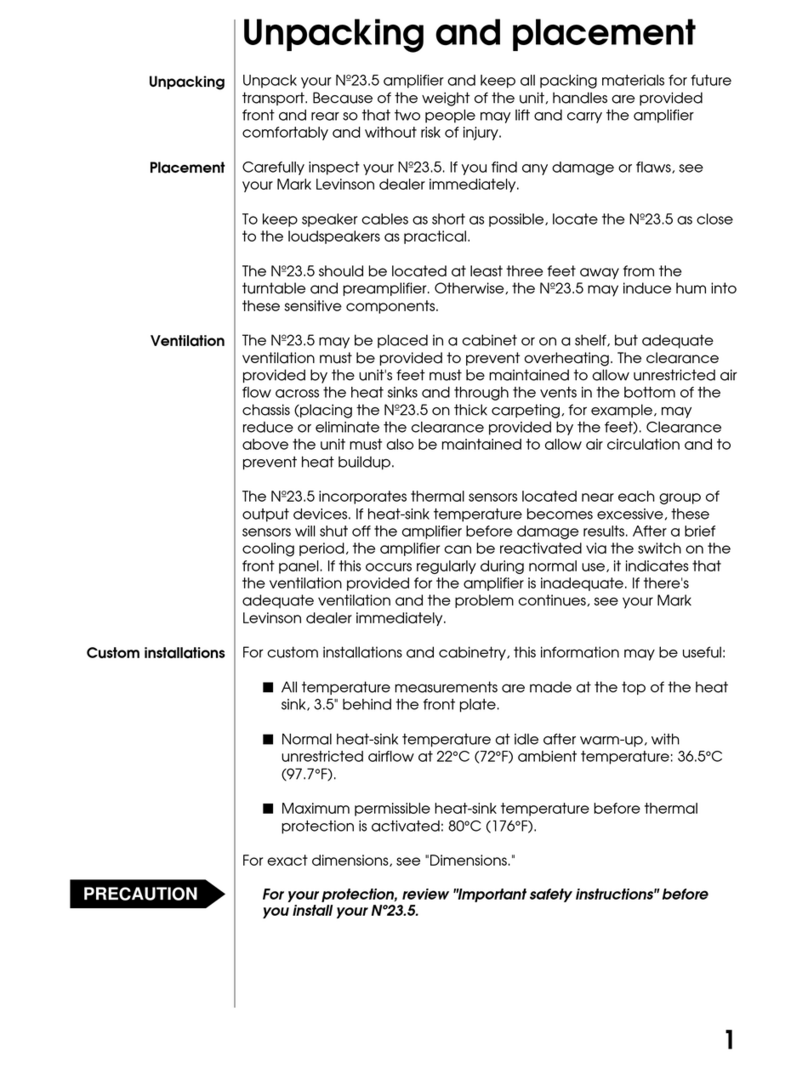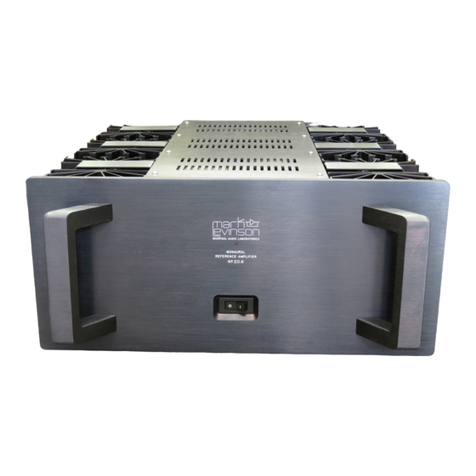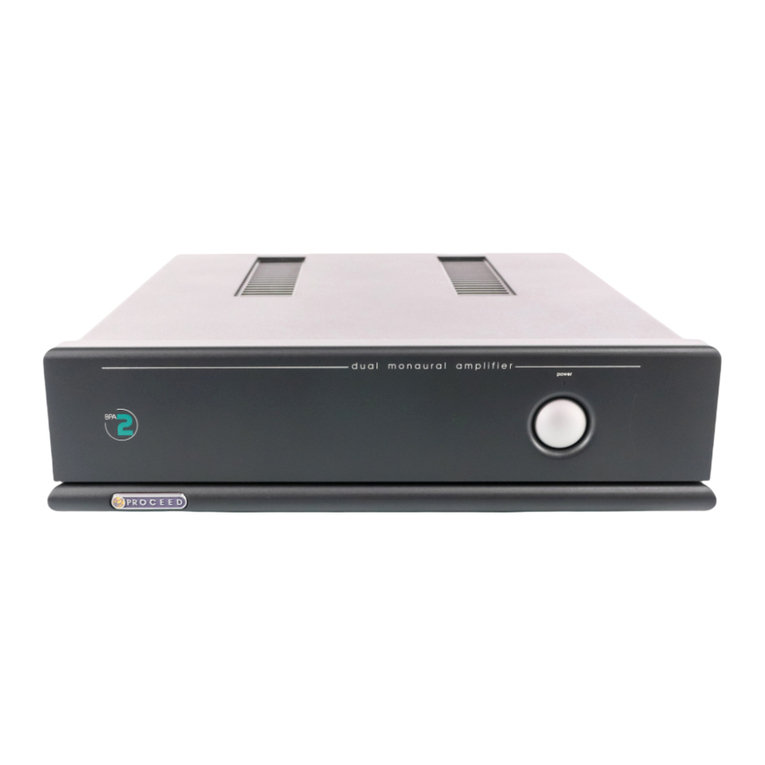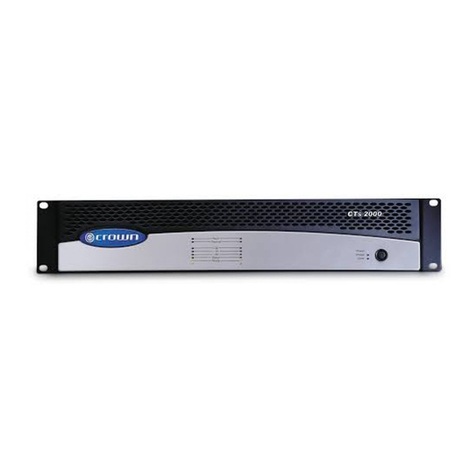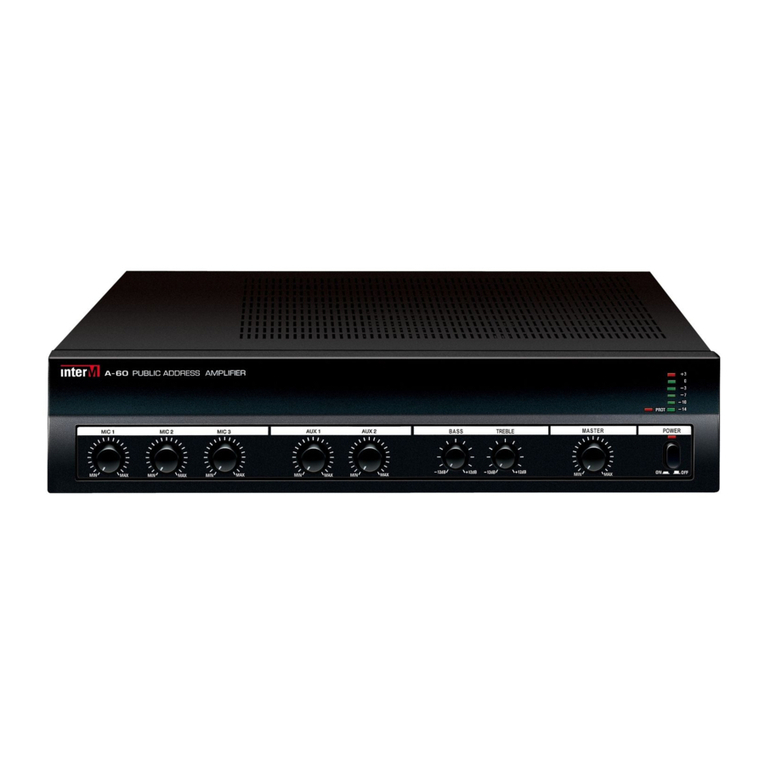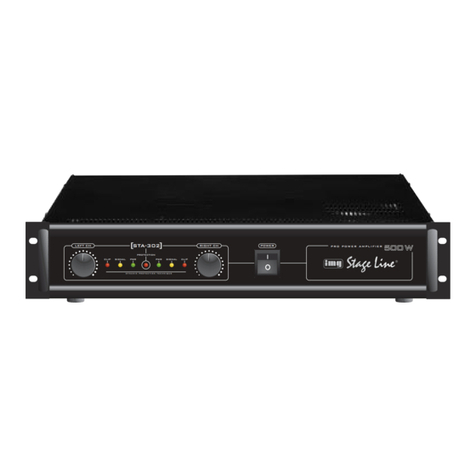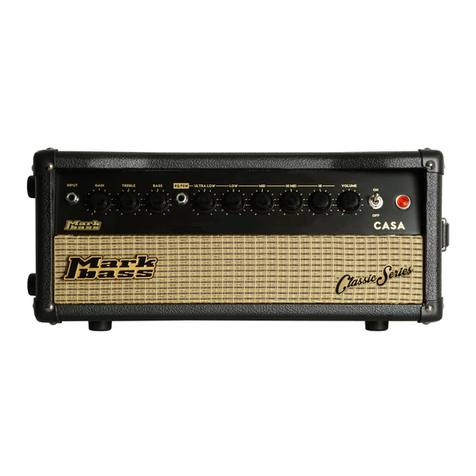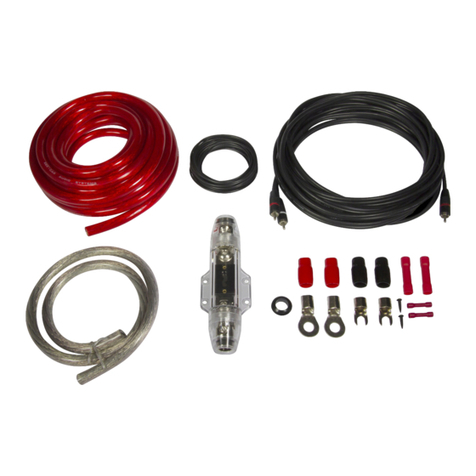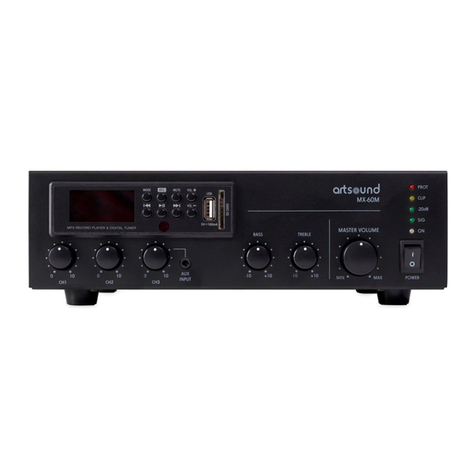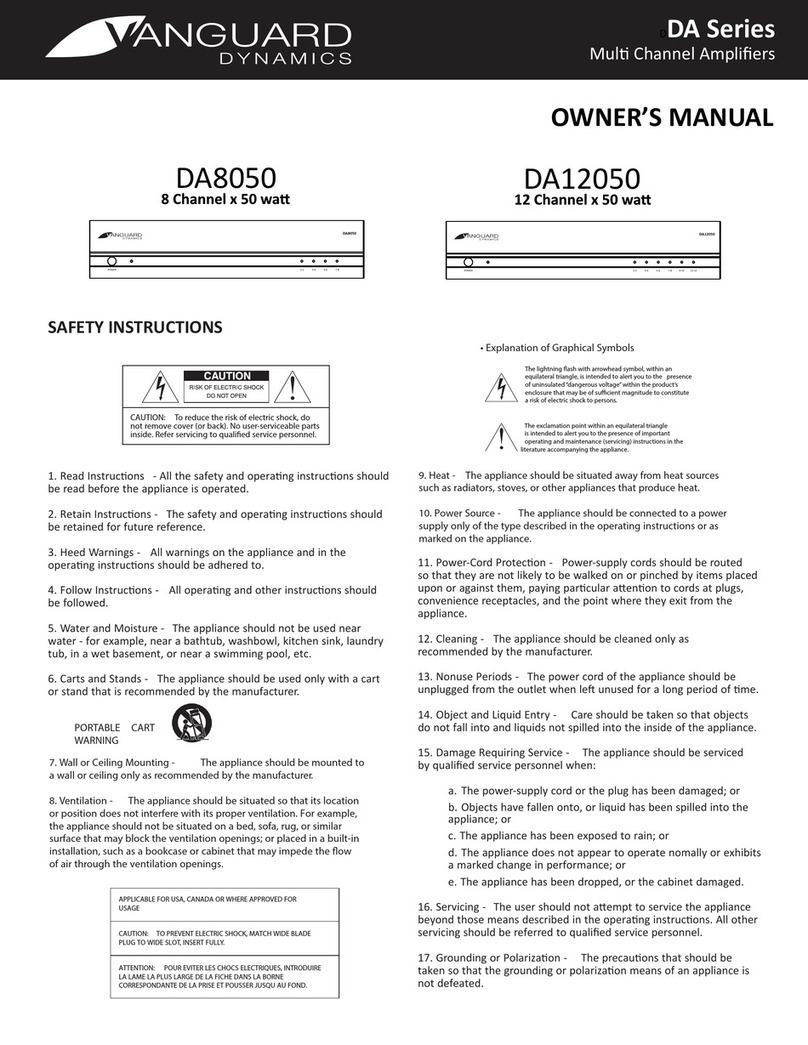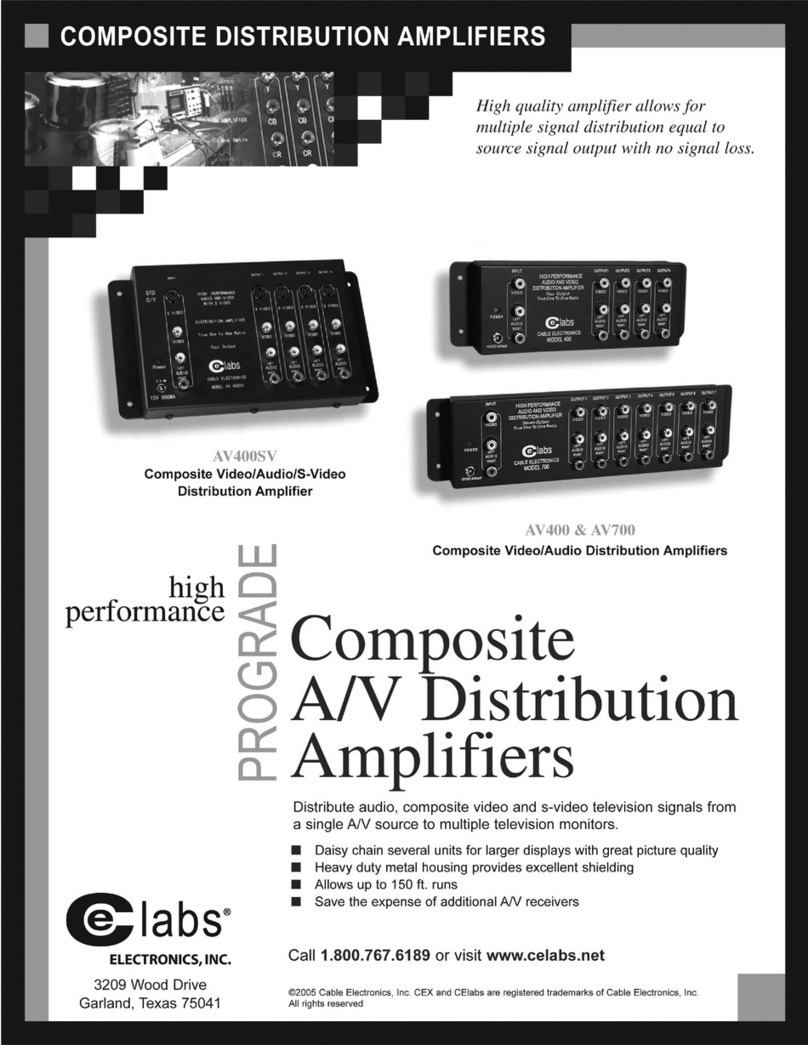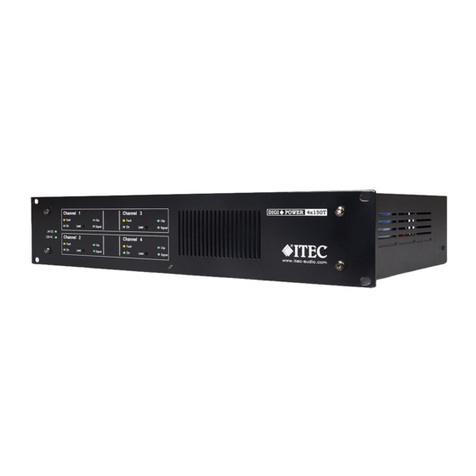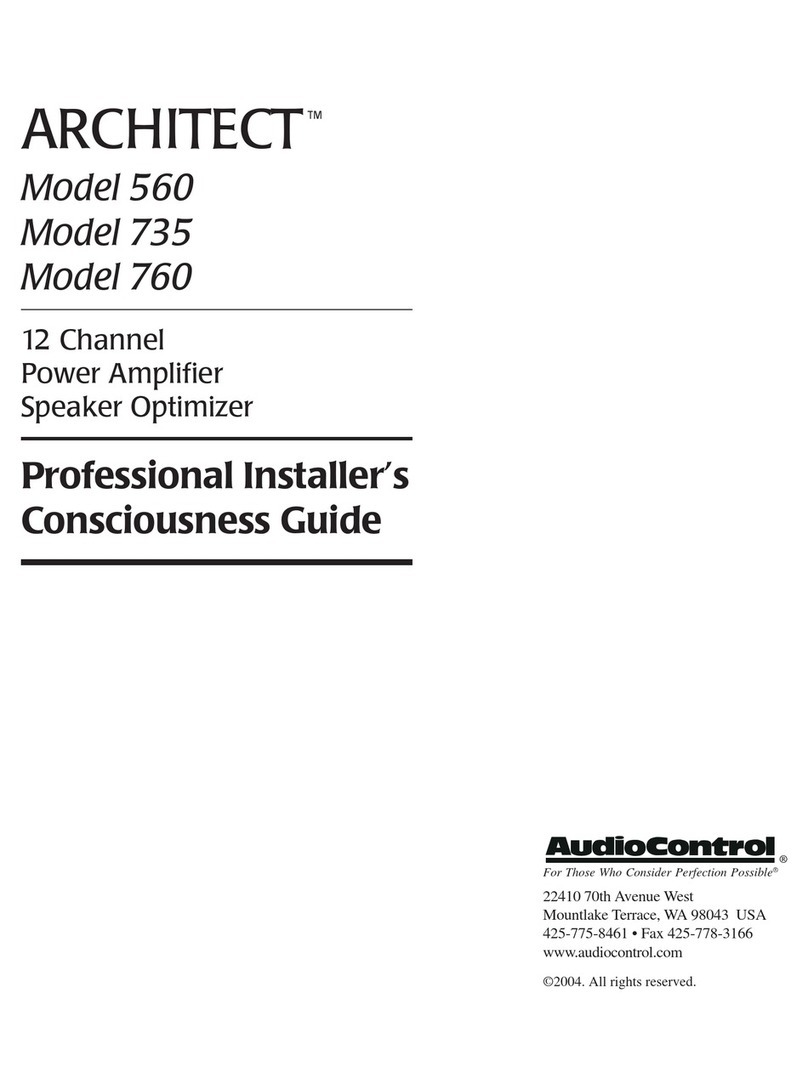Madrigal Audio Five Channel Amplifier User manual

PR O C E E D
FiveChannelAmplifier

2
CAUTION
RISK OF ELECTRIC SHOCK
DO NOT OPEN
CAUTION: TO REDUCE THE RISK OF ELECTRICAL SHOCK, DO
NOT REMOVE COVER. NO USER-SERVICEABLE PARTS INSIDE.
REFER SERVICING TO QUALIFIED PERSONNEL.
WARNING: TO REDUCE THE RISK OF FIRE OR ELECTRIC SHOCK, DO
NOT EXPOSE THIS APPLIANCE TO RAIN OR MOISTURE.
The lightning flash with arrowhead symbol, within an equilateral triangle, is intended to
alert the user to the presence of uninsulated “dangerous voltage” within the product’s en-
closure that may be of sufficient magnitude to constitute a risk of electric shock to per-
sons.
The exclamation point within an equilateral triangle is intended to alert the user to the
presence of important operating and maintenance (servicing) instructions in the literature
accompanying the appliance.
Marking by the “CE” symbol (shown left) indicates compliance of this device with the EMC
(Electromagnetic Compatibility) and LVD (Low Voltage Directive) standards of the
European Community.
The information contained in the manual is subject to change without notice. The most current version of this manual will
be posted on our web site at http://www.madrigal.com.

3
ImportantSafetyInstructions
Please read all instructions and precautions carefully and completely before operating your Proceed power
amplifier.
1. ALWAYS disconnect your entire system from the AC mains before connecting or disconnecting
any cables, or when cleaning any component.
2. This product is equipped with a three-conductor AC mains power cord which includes an
earth ground connection. To prevent shock hazard, all three connections must ALWAYS be
used. If your electrical outlets will not accept this type of plug, an adapter may be purchased.
If an adapter is necessary, be sure it is an approved type and is used properly, supplying an
earth ground. If you are not sure of the integrity of your home electrical system, contact a li-
censed electrician for assistance.
3. AC extension cords are not recommended for use with this product. If an extension cord must
be used, be sure it is an approved type and has sufficient current-carrying capacity to power
this product.
4. NEVER use flammable or combustible chemicals for cleaning audio components.
5. NEVER operate this product with any covers removed.
6. NEVER wet the inside of this product with any liquid.
7. NEVER pour or spill liquids directly onto this unit.
8. NEVER block air flow through ventilation slots or heatsinks.
9. NEVER bypass any fuse.
10. NEVER replace any fuse with a value or type other than those specified.
11. NEVER attempt to repair this product. If a problem occurs, contact your Proceed®retailer.
12. NEVER expose this product to extremely high or low temperatures.
13. NEVER operate this product in an explosive atmosphere.
14. ALWAYS keep electrical equipment out of the reach of children.
15. ALWAYS unplug sensitive electronic equipment during lightning storms.

4
From all of us at Madrigal Audio Laboratories, thank you for choosing this
Proceed power amplifier.
A great deal of effort went into the design and construction of this precision
device. Used properly, it will give you many years of enjoyment.

5
Table of Contents
UnpackingandPlacement ................................................................. 6
Unpacking .......................................................................................................... 6
Placement .......................................................................................................... 6
Ventilation ........................................................................................................... 6
OperatingVoltage .............................................................................. 7
note the serial number ....................................................................................... 7
amplifier bottom-panel label ..................................................................... 7
AQuickStart ...................................................................................... 8
Special Design Features ..................................................................... 10
Multiple power supplies ................................................................................... 10
Low impedance power supply ....................................................................... 10
Balanced inputs ............................................................................................... 10
Robust output stage......................................................................................... 10
Extensive protection ......................................................................................... 10
Home THX Audio System certification.............................................................. 11
FrontPanel ......................................................................................... 12
Rear Panel ......................................................................................... 14
communication cable ............................................................................. 15
Remote turn-on tip polarity ...................................................................... 15
BridgedOperation ............................................................................. 18
Bridging Explained ........................................................................................... 18
Balanced Bridging ........................................................................................... 18
Balanced Bridging Kit ............................................................................... 19
Single-Ended Bridging ...................................................................................... 20
Single-Ended Bridging Kit ..........................................................................21
Biamplification .................................................................................. 23
Balanced Y-adapter ................................................................................. 23
Care&Maintenance ........................................................................ 24
U.S.and Canadian Warranty.............................................................. 25
90-Day Limited Warranty .................................................................................. 25
Five Year Extended Warranty ........................................................................... 25
ObtainingService ............................................................................. 26
Specifications .................................................................................... 27
Dimensions ....................................................................................... 28
InstallationNotes .............................................................................. 29

6
Unpacking and Placement
Unpacking Unpack your Proceed®Five Channel Amplifier and keep all packing m aterials
for future transport. Shipment of the amplifier without the original packing
material is not recommended, as it is heavy enough to make improvised packag-
ing impractical. Locate and remove all accessory items from the cartons, and store
teh cartons for possible future use.
Carefully inspect the product for shipping damage. If you discover any, see your
Proceed dealer immediately.
Placement Your Proceed amplifier may be placed either near the preamplifier/control center
or near the loudspeakers. It may be placed on a shelf or in a cabinet where it is
convenient to operate.
Note that adequate clearance for the AC cord and connecting
cables must be left behind your amplifier. We suggest leaving at
least three inches of free space behind your amplifier to allow all
cables sufficient room to bend without crimping or undue strain.
Ventilation Be sure to allow 2 to 3 inches of clearance above your amplifier to allow heat
dissipation through air circulation. The vents on both the bottom and the top of
the amplifier must be kept free from any obstruction which would reduce the
flow of air through the unit. The best rule of thumb is this: if the top of your am-
plifier is too hot to touch when “idle,” it needs better ventilation. If so, consider
drilling holes in the supporting shelf under the amplifier to promote flow-through
ventilation, or use fans to increase air circulation.
Open equipment racks are generally best for power amplifiers, as they allow
ample ventilation. If your amplifier must be located inside a cabinet which re-
stricts airflow, consider using some fans to increase ventilation.
Avoid placement on soft surfaces such as carpeting. If you prefer to have the am-
plifier on the floor near your loudspeakers, be sure to place it on a firm surface.
(A piece of tempered glass under the amplifier is aesthetically unobtrusive while
providing firm support and allowing the required ventilation.)
Mechanical drawings are included in this manual to facilitate special installations
and custom cabinet work (see “Dimensions” at the end of this manual).
PRECAUTION
For your protection, review “Important Safety Instructions”
before you install your amplifier.

7
Operating Voltage
The Proceed amplifier is factory-set for 100V, 120V, 220V, or 240V AC mains opera-
tion at either 50 or 60 Hz, according to the country for which the unit was manu-
factured. (230V in European Union countries, in compliance with CE regulations.)
Make sure that the label on the rear panel of the amplifier indicates the correct
AC operating voltage for your location. The operating voltage cannot be changed
by the user, and any attempt to do so will void the warranty.
If the voltage indicated does not match the service in your area, see your Pro-
ceed dealer.
note the serial number While you are checking the voltage, it would probably be a good idea to make a
record of the serial number for your amplifier. This can be found on the label
found on the bottom of the amplifier.
amplifier bottom-panel label
five channel amplifier
S/N
WARNING:
BEFORE ATTEMPTING TO OPERATE THIS
DEVICE, REFER TO OWNER'S MANUAL FOR PROPER
OPERATING INSTRUCTIONS AND SAFETY PRECAUTIONS.
HAZARDOUS VOLTAGE AVAILABLE INSIDE; DISCONNECT
AC ~ MAINS CABLE BEFORE OPENING UNIT.
No User Serviceable Components Inside.
For service, contact Madrigal Audio
Laboratories or an Authorized Dealer.Any modifications to this equipment will void all warranties.
Manufactured under license from Lucasfilm Ltd. Additionally licensed under the following
patents: U.S.number 5,043,970; 5,189,703; and 5,222,059.Foreign patents pending.Lucasfilm
THX Audio, Lucasfilm, and Home THX Cinema are registered trademarks of Lucasfilm Ltd.
designed and manufactured in USA
MADRIGAL AUDIO LABORATORIES, INC.
PR O C E E D
R

8
A Quick Start
We recognize that many people are understandably eager to begin listening to
their new components, and that reading the manual is often done (if at all) at a
later time—perhaps while listening to music through the new product itself. We
strongly recommend that you read this manual thoroughly.
Fortunately, we can help you get some music up and running on your system
quickly, so that you may begin enjoying your new amplifier while reading more
about it. The goal here is simply to make some music as quickly as possible.
The following procedure assumes that the rest of your system is already con-
nected (e.g., source components to preamplifier).
1 TURN DOWN THE VOLUME ON YOUR PREAMPLIFIER
Turning the volume on the preamp all the way down minimizes the oppor-
tunity for unpleasant surprises when first powering up your new amplifier.
It does not need to be turned off—merely turned down.
2 SELECT “XLR” OR “RCA”WITH THE “INPUT SELECT” SWITCHES
Each channel of the Proceed Five Channel Amplifier has both balanced
(XLR) and single-ended (RCA) inputs, with a small switch between the two
connectors to select between them. Using these switches, select the appro-
priate input for each channel, given your interconnecting cables and pream-
plifier/controller’s capabilities.
3 CONNECT YOUR PREAMP TO THE AMPLIFIER
Having selected the appropriate inputs in Step 2, now connect the outputs
of your preamplifier to the corresponding inputs on the power amplifier.
4 CONNECT YOUR SPEAKERS TO THE AMPLIFIER
Connect speaker wire from the amplifier to your loudspeakers. Be sure to
maintain consistency in polarity, e.g., the red post on the amplifier to the
red connector on the speaker, and likewise black to black. (Getting the
wires mixed up won’t damage anything, but the sound will be lacking in
bass and the imaging will be quite poor and unstable.)
5 CONNECTTHE AC CORD TO THE AMPLIFIER AND TO YOUR AC OUTLET
The AC receptacle for the power cord is located on the right side of the
rear panel, as seen from the front.
6 TURN ON THE AMPLIFIER BY PRESSING POWER,THEN STANDBY
Press the latching power button on the front panel of the amplifier (small,
near the bottom) to connect the amplifier to the AC mains. The amplifier
will initially power up in standby mode. After five seconds (to let the power
supply charge up), pressing the large silver standby button will bring the
amplifier out of standby into its normal, fully operational mode.

9
7 SLOWLY RAISE THE VOLUME ON YOUR PREAMPLIFIER
Congratulations! You should now be able to enjoy your favorite music while
reading the rest of this manual. (Please, do read the rest of this manual. It
contains much valuable information about your new amplifier which we
could not possibly fit onto these two pages.)

10
Special Design Features
Congratulations on your purchase of a Proceed amplifier! While your new ampli-
fier is straightforward in its use, it includes several design features which are re-
sponsible for its outstanding performance. A few of these are given below.
Multiple power supplies Unlike other multichannel amplifiers, your new amplifier maintains outstanding
isolation and independence among its five channels. Three large toroidal trans-
formers are used, with complete left/center/right channel separation maintained
throughout. Separate secondary windings for front vs. rear channels on the Left
and Right transformers feed separate rectifiers and separate banks of filter caps.
In short, after the transformer, each channel has its own, dedicated power supply.
This approach reduces crosstalk between audio channels for superior imaging
and reproduction of acoustic space. Any demands placed on one channel have
virtually no effect on the performance of the other channel(s).
Low impedance power supply A critical factor in the ultimate performance of an amplifier is its “power supply
impedance,” which can be loosely thought of as the freedom with which the au-
dio circuitry has access to the power it needs, when it needs it. The design of
your Proceed amplifier has addressed this important characteristic in a compre-
hensive fashion. For example, the power supply capacitors (which act as “reser-
voirs” of power for the amplifier circuitry) are mounted directly to the printed
circuit board rather than using point to point wiring. The layout of the circuitry
uses short, thick traces for high current paths. Internal current capability is further
enhanced with high purity copper bus bars. This attention to detail yields an op-
timal environment in which the amplifier may operate to its maximum potential.
Balanced inputs Each channel of your amplifier is individually configurable to receive either bal-
anced or single-ended inputs. This approach allows you to take full advantage of
the greater immunity from noise, RFI, and EMI which balanced transmission of
audio signals offers on any preamp-to-amplifier connection where it is supported.
At the same time, any or all channels of the amplifier may be configured for
single-ended inputs to maintain compatibility with the majority of preamplifiers
available today. The gain structure of the amplifier adjusts automatically when you
select different inputs to facilitate this “mix and match” approach.
Robust output stage Each channel of your Proceed amplifier uses ten 150 watt power transistors.
These transistors are all individually tested and sorted, and are used in matched
sets to ensure that no one transistor bears a disproportionate part of the overall
load. The combination of an “overbuilt” design specification and extraordinary atten-
tion to detail in manufacturing improves performance, reliability, and longevity.
Extensive protection Your Proceed amplifier will shut itself down if it senses either the presence of
either DC (direct current) or a short circuit at the output, or any unsafe operating
temperature. In any case, a power relay will cause the amplifier to be discon-
nected from the AC mains. In addition, the AC input to each transformer is fused
to protect against any possibility of component-level failure that could draw dan-
gerous amounts of power. Finally, inrush limiting prevents premature aging of

11
power supply components during power-up, and switches off-line once the
power supply has been charged.
Home THX Audio
System certification Lucasfilm, Ltd.®has established minimum standards for the performance of vari-
ous components which may be used in their Home THX®Audio System. With
respect to power amplifiers, the standards address such things as:
• a low electrical noise floor to allow low-level information to be
fully appreciated;
• the absence of any mechanical noise (fan noise, transformer wind-
ing buzzes), for the same reason;
• adequate power to meet the demands of modern films (which can
be quite dynamic);
• flat frequency response for accurate reproduction of timbre;
• stability into relatively extreme loudspeaker loads, to ensure that
the amplifier will perform well with a wide range of loudspeakers.
As you can see from this list, there is nothing about the Home THX amplifier
specification that is particularly radical. It simply ensures a certain minimum stan-
dard of performance. In particular, there is nothing in the nature of the amplifier
specification which prevents anyone from going above and beyond the minimum
performance levels required by THX certification.
Your Proceed amplifier is certified for use in Home THX audio systems. Madrigal
engineers have created this powerful, versatile and extraordinarily musical power
amplifier, using the technology and design methodology for which they have be-
come so well known. Equally suited to the rigors of film soundtracks and the fi-
nesse of high end music reproduction, the Proceed Five Channel Amplifier serves
both needs quite well. In today’s growing market for multipurpose systems, it
represents an extraordinary value.

12
five channel amplifier
power
standby
1
2
3
Front Panel
1POWERBUTTON
Pressing this latching power button connects the amplifier to the AC mains,
charges the power supply (which takes about five seconds), and places it in
standby. Having a true standby function keeps the sensitive voltage gain
stages warmed up and sounding their best at all times. Power consumption
when in standby is less than 150 watts.
Note that if the amplifier has been disconnected from the AC mains power
by depressing the front panel power button or by unplugging it from the
AC outlet, it cannot respond to a remote turn-on command from a control
unit. If you wish the amplifier to turn on and off via the Proceed communi-
cations bus (or by a DC trigger), the amplifier needs to be in standby, with
this power button engaged.
2STANDBYBUTTON
Assuming that the power is on and the unit is in standby (see 1, above),
pressing the standby button engages the output stage of the amplifier, tak-
ing it from standby to fully on. Pressing the standby button again will
toggle the amplifier back to standby. Power consumption when fully on and
at idle is less than 250 watts.
At your option, you may also toggle the amplifier between standby mode
and fully on by connecting a suitable 5-12V DC trigger such as can be pro-
vided by the Proceed PDSD or AVP to its remote trigger input.
Note that pressing the standby button has no effect until after the power
supply is fully charged.

13
Note also that if the amplifier has been disconnected from the AC mains
power by depressing the front panel power button, it cannot respond to a
remote turn-on command from a control unit.
3 INDICATOR LIGHTS
The power indicator light (above the small power button, below the large
standby button) is normally either on or off, indicating whether AC power
is being supplied to the amplifier. It will blink on and off if the amplifier’s
protection circuitry has been engaged (shutting the amp off to protect itself
and/or your loudspeakers). In the unlikely event that you see the power
indicator blinking, disconnect the amplifier from AC power and call your
dealer for assistance in solving the problem.
The standby indicator light (above the large standby button) glows either
amber or red, depending on the operational status of your amplifier. Amber
indicates that the amplifier is on and ready to be used. When the indicator
light is glowing red, the unit is in standby. If the standby indicator light is
completely off, the amplifier is not receiving power. Check your AC connec-
tions and the rear-panel AC fuse.

14
PUSH
input select
input select
input select
input select
PUSH
PUSH
PUSH
PUSH
right front right rear center
input select
left rear left front
trigger
inputs communication
ports
~ac
mains
outputs
outputs
outputs
outputs
outputs
five channel amplifier by MADRIGAL AUDIO LABS made in u.s. a.
PR O C E E D
R
1 4 5 6 72 3
Rear Panel
Caution! Turn the volume on your controller/preamplifier all the way
down before attempting to connect anything to your Proceed
Five Channel Amplifier.
1 AC MAINS RECEPTACLE
Connect the AC power cord (included in the accessory pack) to the IEC-
standard AC receptacle on the rear panel of the amplifier, then to the AC
mains outlet.
Warning! Your Proceed amplifier has been safety-tested and is
designed for operation with a three-conductor power cord.
Do not defeat the “third pin” or earth ground of the AC power
cord.
2 COMMUNICATION PORTS
These RJ-45 communications ports provide for sophisticated inter-compo-
nent communications within the context of a Proceed system, allowing the
multichannel controller to toggle the amplifier between operate and
standby as needed, without forcing the user to turn the amplifier on sepa-
rately. Since this communication link provides two-way communication, it is
more reliable and preferred over simpler DC trigger hookups (although we
support DC triggers as well, since their use is so widespread).

15
These two RJ-45 communications ports also support the PHAST™ inter-
component communications protocols, greatly simplifying the design and
installation of sophisticated home automation systems. They provide two-
way communication with the home automation controller as to the
amplifier’s current status, ensuring reliable execution of sophisticated turn-
on and shutdown macros.
To use these ports, simply daisy chain the various Proceed products to-
gether. The modular cable needed for the connection may be purchased
from your Proceed dealer. It may also be easily and inexpensively made to
length using two modular connectors and the appropriate length (up to 100
feet/30 meters) of flat, eight conductor cable.
Modular cables and connectors are used throughout the world for both tele-
communications and computers, and are widely available at low cost. The
connectors are crimped on to the ends of the cable such that pin 1 at one
end is connected to pin 1 at the other end. Such a “straight-through” con-
nection is (counter-intuitively) made by introducing a 180°twist in the
cable between the two ends, as shown below.
communication cable
from Proceed PDSD or AVP To Five Channel Amplifier
Locking tabLocking tab
3 REMOTE TURN-ON (“TRIGGER’) JACKS
Two 1⁄8" “mini” jacks above the AC mains receptacle on the rear panel al-
lows remote-controlled turn-on (that is, toggling between operate and
standby) of the Proceed amplifier. These remote “triggers” will be operated
by the presence of 5–12 volts DC, with tip polarity as shown below:
Remote turn-on
tip polarity
+–
5-12 volts,
positive tip
polarity
The presence of a suitable DC voltage will cause the amplifier to be fully
on; the absence of such a voltage will cause it to enter standby. Your Pro-
ceed dealer can help you take advantage of these design features to maxi-
mize your system’s versatility.
Since these trigger inputs are wired in parallel, you can go into one and
out of the other to facilitate a “daisy-chain” of turn-on triggers (should you
have additional products that need to be controlled in this manner).
Special not e: if this method of control is used for the amplifier(s), the last
mini-jack in the chain must be terminated with a dummy 1⁄8" plug [that is,
an empty plug must be inserted into the final 1⁄8" (3.5 mm) jack]. Even if
only a single amplifier is controlled in this fashion, the “extra” mini-jack
must be terminated.

16
If you are not using these turn-on inputs, you may leave them both empty
of any plugs.
4 BALANCED AUDIO INPUTS
Accepts signals from preamplifiers with balanced outputs via high quality
XLR connectors.
The pin assignments of these XLR-type female input connectors are:
PUSH
21
3
Pin 1: Signal ground
Pin 2: Signal + (non-inverting)
Pin 3: Signal – (inverting)
Connector ground lug: chassis ground
These pin assignments are consistent with the standards adopted by the
Audio Engineering Society. Refer to the operating manual of your balanced-
output preamplifier to verify that the pin assignments of its output connec-
tors correspond to your Proceed amplifier. If not, wire the cables so that the
appropriate output pin connects to the equivalent input pin.
If you are planning to use balanced connections between your preamplifier
and any particular channel of the amplifier, select the balanced input by
sliding the input select switch (see Item 5, below) toward the XLR input.
Then connect the balanced outputs of your preamplifier to the correspond-
ing balanced inputs on the amplifier using high quality cables such as CZ
Gel-1.
5 INPUT SELECT SWITCH
This small switch is found between the balanced XLR input and the single-
ended RCA input on each channel of the amplifier. Use it to select which of
the two inputs you plan to use.
The input select switch disables the unselected input in order to avoid any
pickup of stray noise from what would otherwise be an open input. It also
causes the effective gain of that channel to be adjusted (either 23 dB bal-
anced or 29 dB single-ended, to compensate for the 6 dB difference in sig-
nal level in these two connection standards). Should you use your amplifier
in a home theater system, this adjustment allows you to use any combina-
tion of balanced and single-ended connections without having to worry
about going outside the adjustment range of your surround decoder’s out-
put calibration circuitry.
6 SINGLE-ENDED INPUTS
Accepts signals from preamp/controllers with single-ended outputs via high
quality RCA connectors.
If you are planning to use single-ended connections between your pream-
plifier and any particular channel of the amplifier, select the single-ended
input by sliding the input select switch (see Item 5) toward the RCA input.
Then connect the single-ended outputs of your preamplifier to the corre-
sponding single-ended inputs on the amplifier, using high quality cable
such as CZ Gel-2.

17
7 SPEAKER OUTPUTS & BINDING POSTS
The Proceed amplifier is equipped with gold-plated, high-current binding
posts for output termination to a loudspeaker system. To take full advantage
of the AMP’s sonic quality, we recommend using high-quality␣ speaker cable;
see your Proceed dealer.
Caution! NEVER connect the amplifier output terminals to any device
other than a loudspeaker.
NEVER short-circuit the amplifier’s output terminals.
There are two recommended methods for connecting speaker cables to the
amplifier. A high-quality␣ spade lug or hook lug, soldered to the cable (or
crimped with extremely high pressure), is best.
Spade lug Hook lug
For each channel in turn, connect the left-channel –(negative or black) out-
put post of the amplifier to the –(negative or black) input terminal of the
appropriate loudspeaker.
Then connect the +(positive or red) output post of the amplifier to the +
(positive or red) input terminal of the appropriate loudspeaker.
Repeat this procedure for all remaining channels.

18
Bridged Operation
Your Proceed amplifier has been designed to be extremely versatile. Should your
needs change or grow over time, you may wish to add additional power by one
of two means: Bridging, or Biamping. We will discuss bridged operation first.
Bridging Explained Bridging refers to the act of reconfiguring the circuitry in two channels of your
amplifier to act as though it were a single, much larger amplifier. (Of course, this
reduces the number of available channels; you may need more amplifiers to
make up the difference.)
Bridging is accomplished by sending a normal signal to one channel and an in-
verted signal to the other. In this configuration, one channel will always be “push-
ing” when the other is “pulling.” By connecting the loudspeaker leads across the
left and right red output terminals, the amplifier can now deliver twice the nor-
mal voltage to the loudspeaker. Working together this way, the two amplifier chan-
nels can deliver about four times the power to a speaker that a single channel
could deliver on its own.
Bridged operation is particularly beneficial with low sensitivity, high-impedance
loudspeakers (8Ωor higher) that have a greater need for voltage than for current.
It is not recommended for low-impedance loudspeakers, as the speaker’s imped-
ance is “split” by the two halves of the amplifier. Thus the bridged amplifier “sees”
a 2Ωload when connected to a 4Ωloudspeaker. Delivery of high power into
such a low impedance creates a great deal of heat that needs to be dissipated.
(Of course, your amplifier is protected against overheating, but having an ampli-
fier shut itself down even temporarily can put a damper on the evening’s enter-
tainment.)
Balanced Bridging If your preamplifier has balanced outputs, you should use them. For this discus-
sion, we will assume that you are using a Madrigal Balanced Bridging Kit for
each channel to be bridged. (Alternatively, you may have custom cables built us-
ing your preferred wire and connectors, being careful to follow the wiring dia-
gram below.)

19
Balanced Bridging Kit
21
3
12
3
12
3
Female XLR Input
Pin 1: signal ground
Pin 2: signal + (non-inverting)
Pin 3: signal – (inverting)
Male XLR Output (normal)
Pin 1: signal ground
Pin 2: signal + (non-inverting)
Pin 3: signal – (inverting)
Male XLR Output (inverted)
Pin 1: not used (floated)
Pin 2: signal – (inverting)
Pin 3: signal + (non-inverting)
Balanced Bridging
Input Adapter
(pin configuration)
Bridging Output Adapter
(not drawn to scale)
(shield not connected)
The “normal” leg of the Madrigal Balanced Bridging Input Adapter will be marked
with a red stripe to indicate positive polarity, and the inverted leg will be marked
with a black stripe to indicate inverted polarity (corresponding to the red and
black terminals of your loudspeaker).
The Balanced Bridging Output Adapter is simply a heavy-gauge copper bar (sil-
ver- and gold-plated) used to strap two of the output ground terminals together.
This establishes a common reference for the amplifier and completes the circuit
that includes the loudspeakers.
Important! Do not attempt to operate your amplifier in a bridged mode
without first strapping the black output terminals together.
Failure to establish a common ground reference between the
two channels can damage your amplifier by forcing
significant currents to flow where they do not belong!
To bridge your amplifier using a balanced input signal, follow these steps:
1 DISCONNECT YOUR AMPLIFIER FROM EVERYTHING
Start with your amplifier totally disconnected from inputs, outputs, and AC
power. It is always best to power down an amplifier before changing con-
nections; here you are also changing its basic configuration, making this
step essential.
2 CONNECTTHE BALANCED BRIDGING INPUT ADAPTER TO THE INPUTS
Connect the two male XLRs to two adjacent inputs on your amplifier, not-
ing which XLR is marked red and which is black. The channel with the red,
normal input will later be connected to the red, positive terminal of your
loudspeaker. Don’t forget to choose the balanced input on each channel us-
ing the switch located between the XLR and the RCA connectors.

20
3 CONNECTTHE BALANCED BRIDGING OUTPUTADAPTER TO THE TWO
BLACK OUTPUT TERMINALS
Connect one end of the Balanced Bridging Output Adapter to a black out-
put terminal on one of the two channels to be bridged together, and then
connect the other end of the Output Adapter to a black output terminal on
the other channel. Make sure these connections are snug and secure. (If
you need to use two channels of a different spacing—for example, two
center channel in different amplifiers—you can use a heavy gauge speaker
wire for this purpose.)
4 CONNECTYOUR LOUDSPEAKER WIRE ACROSS TWO RED OUTPUT TERMI-
NALS, ONE TO EACH OF THE TWO CHANNELS BEING BRIDGED
Please read the following carefully:
Connect the positive/+/red binding post of your loudspeaker to the red
output terminal associated with the red (normal) side of the Input Adapter.
Connect the negative/–/black binding post of your loudspeaker to the red
output terminal on the other side of the amplifier, the one associated with
the black (inverted) side of the Input Adapter.
Following this connection convention preserves the polarity of the signal
sent to the loudspeaker. In practice, the most important thing is to be con-
sistent throughout the system, as inconsistency will result in out-of-phase
loudspeakers. In turn, this results in unstable imaging and poor bass repro-
duction. (The effect is not dangerous, but neither is it desirable.)
5 CONNECT ONE OUTPUT CHANNEL OF YOUR PREAMPLIFIER TO THE IN-
PUT OF YOUR BRIDGED AMPLIFIER
The female XLR at the junction of the Balanced Bridging Input Adapter is
now the single input to this bridged pair of amplifier channels.
6 POWER UP YOUR AMPLIFIER
Plug the amplifier back into the AC mains; press the power button to turn
on the amplifier.
7 REPEATTHIS PROCESS WITH YOUR OTHER AMPLIFIER(S)
Single-Ended Bridging If your preamplifier has only single-ended (RCA) outputs, a few details of
bridged operation will differ from the discussion above, all pertaining to the con-
nection of the preamp to the bridged amplifiers. For this discussion, we will as-
sume that you are using a Madrigal Single-Ended Bridging Kit for each channel to
be bridged. (Alternatively, you may have custom cables built using your preferred
wire and connectors, being careful to follow the wiring diagram below.)
This manual suits for next models
1
Table of contents
Other Madrigal Audio Amplifier manuals
